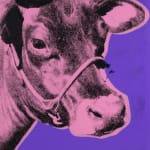-
Artworks


Andy Warhol
Cow Wallpaper F.S. II 12 A, 1976Screen print on wall paper45 1/2 x 29 3/4 in
115.6 x 75.6 cmEdition of unknown size with approximately 100 signed in felt pen in 1979 ; Stamped and authenticated by the Andy Warhol Foundation For The Visual ArtsSeries: Cow WallpapersCopyright The ArtistAndy Warhol's Cow Wallpaper is one of the iconic creations that emerged from the vibrant world of Pop Art in the 1960s. Created in 1966 as a part of Warhol's exploration into mass production and consumer culture, the Cow Wallpaper epitomizes his fascination with the repetition of images and the blurring of lines between high art and everyday life. Inspired by the imagery of cows commonly found in American culture – from dairy advertisements to children's books – Warhol took this mundane subject matter and transformed it into an art form that challenged conventional notions of aesthetics and taste. The repetitive pattern of the cow prints, rendered in vivid colors such as pink, yellow, and blue, creates a visually striking and immersive environment. The Cow Wallpaper was not merely a static piece of art but rather a dynamic installation that engulfed the viewer, blurring the boundaries between art and the surrounding space. It became a symbol of Warhol's belief in the democratization of art – the idea that art should be accessible to everyone, not just confined to elite galleries or museums. Furthermore, the Cow Wallpaper served as a commentary on the commodification of art and consumerism in society. By transforming a commonplace image into a decorative pattern, Warhol challenged the notion of artistic authenticity and questioned the value placed on originality in a mass-produced world. The Cow Wallpaper remains a significant symbol of Warhol's artistic legacy, embodying his innovative approach to art-making and his ability to transform the ordinary into the extraordinary. Its influence can still be seen today in contemporary art and design, serving as a reminder of Warhol's enduring impact on popular culture.Andy Warhol’s Cow (FS.II 12A) (1976) is a screenprint on wallpaper that exemplifies the artist’s ability to transform even the most pastoral and traditional subjects into icons of Pop Art. Prior to creating the Cow series, Warhol was best known for works that centered on the commercial and the famous—soup cans, soda bottles, and silver-screen stars. But in the mid-1960s, art dealer Ivan Karp encouraged Warhol to explore subjects that were more universal and enduring in art history. Karp proposed cows—“wonderfully pastoral,” he remarked, and “a durable image in the history of the arts.”
With Cow 12A, Warhol applied his signature Pop aesthetic—bold color, repetition, and graphic contrast—to an age-old motif, challenging the notion that Pop Art must focus solely on celebrity or commercial imagery. The result is a series that expands the definition of what can be commodified through art. Though the subject is bucolic and traditional, Warhol's treatment transforms it into something loud, playful, and unmistakably modern.
This work marks a turning point in Warhol’s career. While still engaging with themes of mass production and surface-level appeal, the Cow series reflects a broader artistic inquiry: how meaning shifts when a familiar subject is filtered through the lens of Pop Art. Cow 12A, the final image in the series, crystallizes this transformation. With its aggressive use of color and electric contrast, it has the same arresting visual impact as Warhol’s celebrity portraits—despite depicting a farm animal rather than a film star.
Importantly, the Cow series also inaugurated Warhol’s exploration of wallpaper as a medium. First used to line the walls of his gallery exhibitions, the wallpaper became a backdrop as striking as the works themselves. Visitors to the inaugural Cow wallpaper installation were greeted with rows of vibrantly colored cows, flooding the space with a surreal, almost psychedelic atmosphere.
While Warhol often used complementary colors to create contrast, Cow 12A achieves its pop sensibility by pushing both foreground and background into the realm of the vividly saturated. The image feels both chaotic and comical, lending the piece a whimsical, almost cartoonish quality. The cow seems to pulsate with unnatural intensity—like a cow on an acid trip—evoking amusement and fascination in equal measure.
Ultimately, Cow 12A underscores Warhol’s power to universalize his style. The cow, long a subject of traditional art, is here transformed into a mass-produced icon. Warhol didn’t need a brand or a movie star to achieve Pop; he needed only the right treatment. Through the Factory’s silkscreen process, even a cow becomes a commodity—and in doing so, a Warhol.
For more information on Andy Warhol’s Cow (FS.II 12A) or to buy Cow (FS.II 12A), contact our galleries using the form below.%3Cdiv%20class%3D%22artist%22%3EAndy%20Warhol%3C/div%3E%3Cdiv%20class%3D%22title_and_year%22%3E%3Cspan%20class%3D%22title_and_year_title%22%3ECow%20Wallpaper%20F.S.%20II%2012%20A%3C/span%3E%2C%20%3Cspan%20class%3D%22title_and_year_year%22%3E1976%3C/span%3E%3C/div%3E%3Cdiv%20class%3D%22medium%22%3EScreen%20print%20on%20wall%20paper%3C/div%3E%3Cdiv%20class%3D%22dimensions%22%3E45%201/2%20x%2029%203/4%20in%3Cbr/%3E%0A115.6%20x%2075.6%20cm%3C/div%3E%3Cdiv%20class%3D%22edition_details%22%3EEdition%20of%20unknown%20size%20with%20approximately%20100%20signed%20in%20felt%20pen%20in%201979%20%3B%20Stamped%20and%20authenticated%20by%20the%20Andy%20Warhol%20Foundation%20For%20The%20Visual%20Arts%3C/div%3E%3Cdiv%20class%3D%22series%22%3E%3Cspan%20class%3D%22artwork_caption_prefix%22%3ESeries%3A%3C/span%3E%20Cow%20Wallpapers%3C/div%3E
Join our mailing list
* denotes required fields
We will process the personal data you have supplied in accordance with our privacy policy (available on request). You can unsubscribe or change your preferences at any time by clicking the link in our emails.
This website uses cookies
This site uses cookies to help make it more useful to you. Find out more about cookies.







